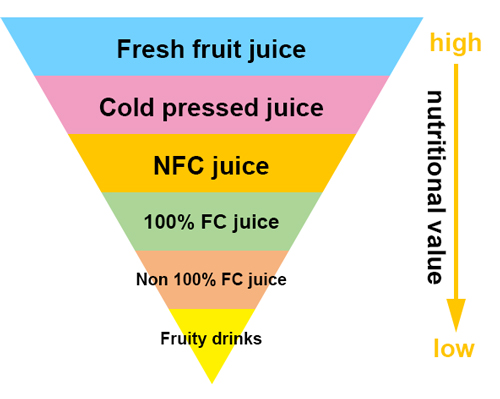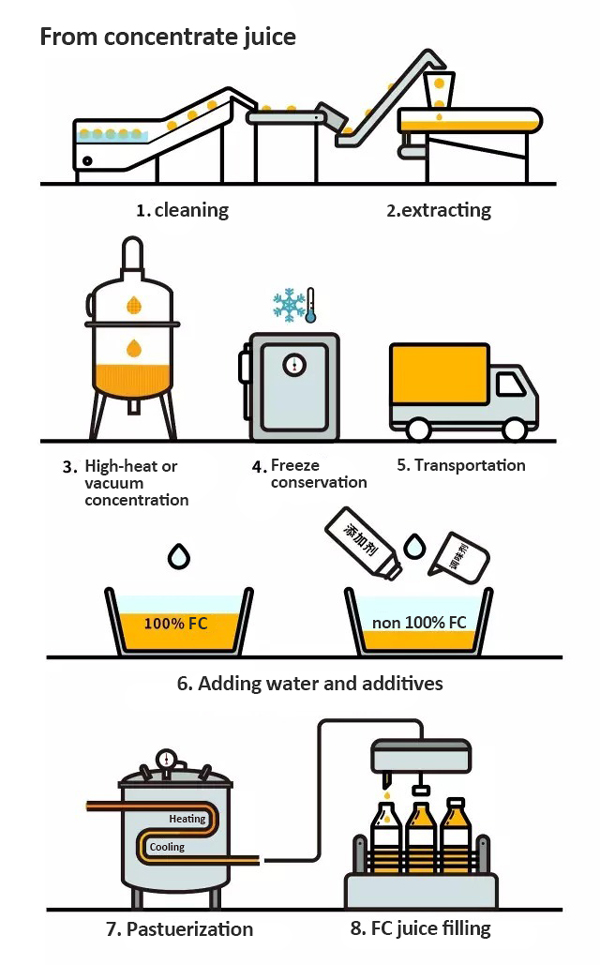Nutritional value of different types of fruit juice
In brief, there are 5 types of fruit juice on the market. They are fresh fruit juice, FC juice (from concentrate juice), NFC juice (not from concentrate), cold press juice and fruity drinks. Their nutritional value from high to low are fresh fruit juice, cold press juice, NFC juice, 100% FC juice and fruity drinks. You can refer to this pyramid to identify their nutrition level.

Fresh fruit juice
Fresh fruit juice is squeezed at home or in the juice shop. They are directly made by feeding fresh fruits to the fruit juicer. These fresh fruit juice are filled into cups or bottles without sterilization. It can preserve most freshness and taste of fruits, but it is easy to oxidize or go bad. Their shelf life is so short, and cannot sold in the supermarket. You’d better drink it right after it is extracted. Don't keep it more than a day.
FC juice
FC means “from concentrate”. The extracted juice is concentrated by high-heat or vacuum treatment, and recovers by adding the same quantity of water. After sterilization and packing, they can be put on the shelves. FC juices can be preserved at room temperature for several months.
We can indentify the FC juice according to its ingredient list. FC juice drinks always contains concentrated juice and water in its ingredient list. Besides, it is usually added with sugar, syrup, essence, thickener, preservatives, etc.
In supermarkets, many fruit juices are labeled with “100% pure fruit juice”. They are usually FC juice. But FC juice is not necessarily 100% juice. If fruit juice has 90% of the water removed during concentration, and it is added with 90% water for recovery, it can be called 100% fruit juice. If the added water is more than the quantity of removed water, it is FC juice but not 100% juice. The fruit juice content in fruit drinks can be as low as 10%, according to the national standard.

Why do they concentrate fruit juice first and dilute it again?
These process can reduce the cost of transportation, storage and production.
Usually, the fruit production area is far from the target market. By concentration, they can reduce the volume of fruit juice dramatically, and save the cost of transportation. Besides, the concentrated juice can be preserved for longer time. Because the sugar content become so high that microbes can not live under such high osmotic pressure. For these 2 reasons, FC juice become the mainstream of the market.
But FC juice is not as tasty as fresh fruit juice. In the concentration process, some soluble flavor substance will get lost. And in the sterilization process, high temperature can cause flavor reversion.
NFC juice
NFC means “Not from concentrate”. It doesn’t need the process of concentration or recovering. It is made by pasteurizing fresh fruit juice, and packing it in bottles. The ingredient list of NFC juice only contains fruit juice, without any additives, sugar, or water.

Pasteurization is to heat up fresh juice to a certain temperature and cool it suddenly. It can eliminate the microbes in fruit juice and prolong its shelf life. They are usually placed in refrigeration blocks.

What's the difference between NFC juice and fresh juice?
NFC juice need to be pasteurized to prolong its shelf life. NFC juice can be preserved in cold chain for around a month. Fresh fruit juice don’t have pasteurization process, so you need to drink it up right after your buying it. Although NFC juice can reserve more flavor than FC juice, it is not as tasty as fresh fruit juice because of the pasteurization process.
Comparison between NFC juice and FC juice
Without dehydration or adding water, NFC only need the sterilization process, so it preserves more enzymes and vitamins than FC juice. Also, it has better taste and freshness.
The shelf life of NFC juice is around 1 month in cold storage, while FC juice can be preserved for years. NFC juice is more expensive than FC juice because of the increasing cost in storage and transportation.
100% fruit juice can be either FC juice or NFC juice. But NFC juice is directly extracted, and FC juice is recovered concentrated juice. Given their production process, NFC is more pure than FC juice.
Cold pressed juice
Cold press requires the whole fruit juice production process, including cleaning, extracting and bottling, is carried out under low temperature and prevented from oxidation. In this way, we can preserve the color, flavor and nutrient content as much as possible.

Traditionally, fruit juice is extracted by crushing the fruits with fast-spinning blades. But the crushing process will heat up the fruit pulp and cause some flavor and nutrition loss. In cold press technology, the fruit juice is extracted by pressing rather than cutting, so the temperature doesn’t rise up and the flavor and nutrition won’t be destroyed.
Traditional sterilization method is pasteurization and UHT technology. They both heat up the juice to a high temperature and last for a while. But the high temperature will damage quality and flavor of fruit juice. The cold press adopts high pressure processing (HPP). The Fruit juice is placed under 600Mpa pressure, where most microbes can not survive. With HPP technology, the fresh fruit juice can be preserved for more than 40 days.

The cold press and HPP technology can preserve the flavor and nutrition of fruit juice effectively, and prolong the shelf life to meet industrial standard. But cold pressed juice is too expensive to afford. In America, a bottle of cold pressed juice is $20, so it is not popular among common people. We hope there is technology breakthrough in the future that can lower the production cost of cold pressed juice.
Fruity drinks
Cold pressed juice is 100% fruit juice. NFC juice is nearly 100%, but with at most 5% additives content. The most frequently seen is still FC juice, their concentrated juice content should be no less than 10%. If the concentrated juice proportion is less than 10%, it can only be called fruity drinks. They are not fruit juice but drinks with fruit taste. Don’t hope it can supplement nutrition to your body.

How to pick fruit juice?
Keep away from fruity drink
NFC and cold pressed juice are nearly 100% juice. FC juice has the fruit juice content between 10%-90%. Fruity drinks contains less than 10% pure fruit juice, so its nutritive value is low.
Less sugar and additives
Certain quantity of food additives is acceptable. If you want to drink pure fruit juice, NFC and cold pressed juice is your first choice. Most 100% FC juice contains only water and concentrated juice. If the fruit juice contain many kinds of sugar, essence and other additives, it is far from pure fruit juice.
Refer to the price
NFC juice is more expensive than FC juice. And cold-pressed juice is much more expensive than both of them. If you don't want to speed too much on fruit juice, 100% FC juice is a good choice. You can also make your own fresh fruit juice with a fruit juicer.
Don’t rely on fruit juice to lose weight
Drinking fruit juice to lose weight is unscientific. Most fruit juice contains high sugar and calorie, some even with additional sugar. Besides, fruit juice is short of protein, fat and dietary fibers. It can induce satiety but will cause nutritional imbalance. In a word, we should drink fruit juice properly, don't use it to replace staple food.
Get in Touch Now!













